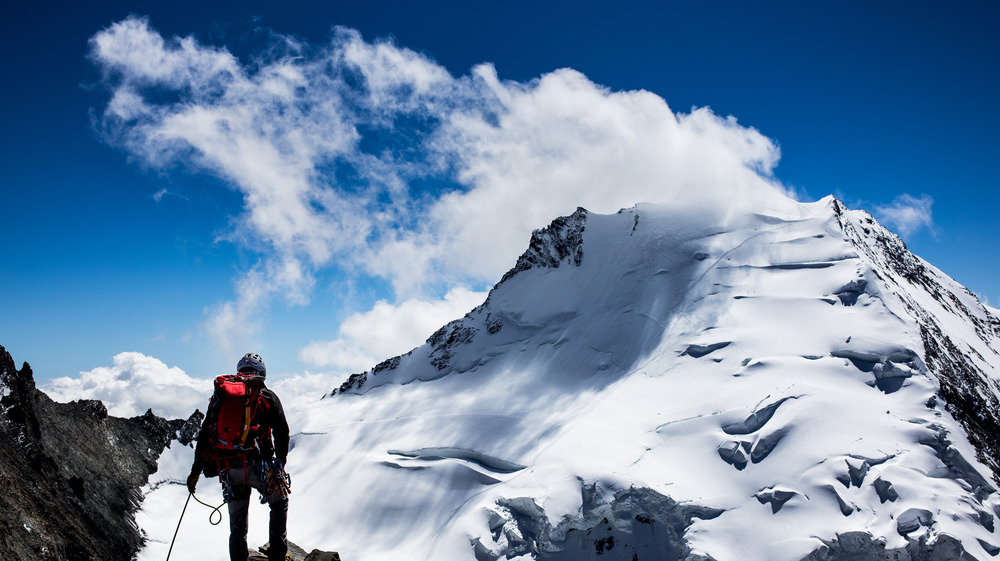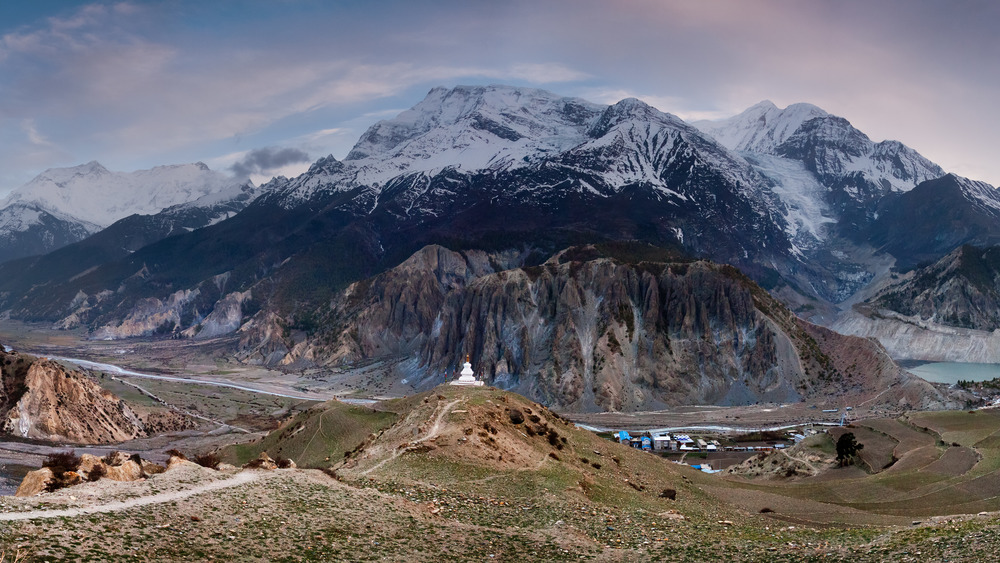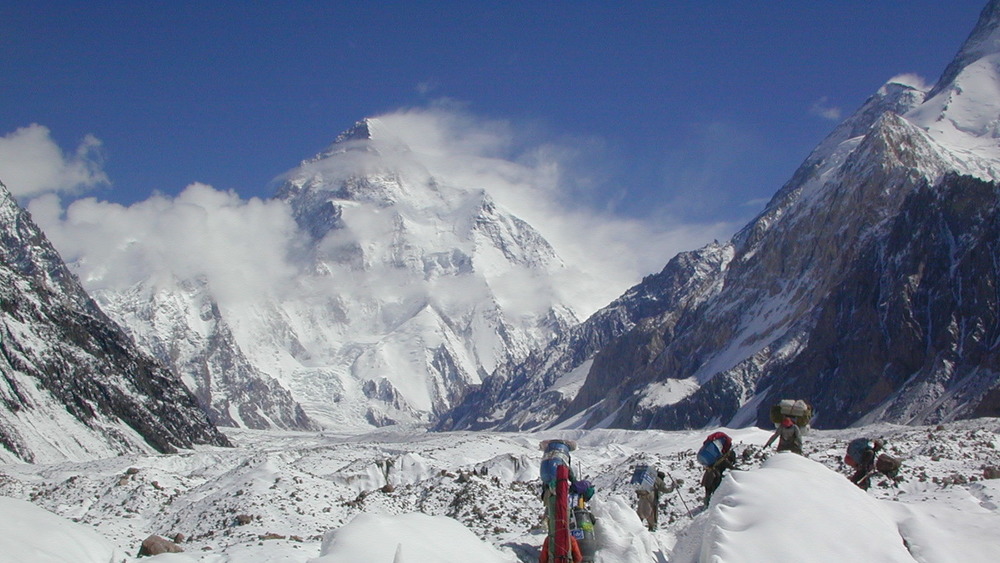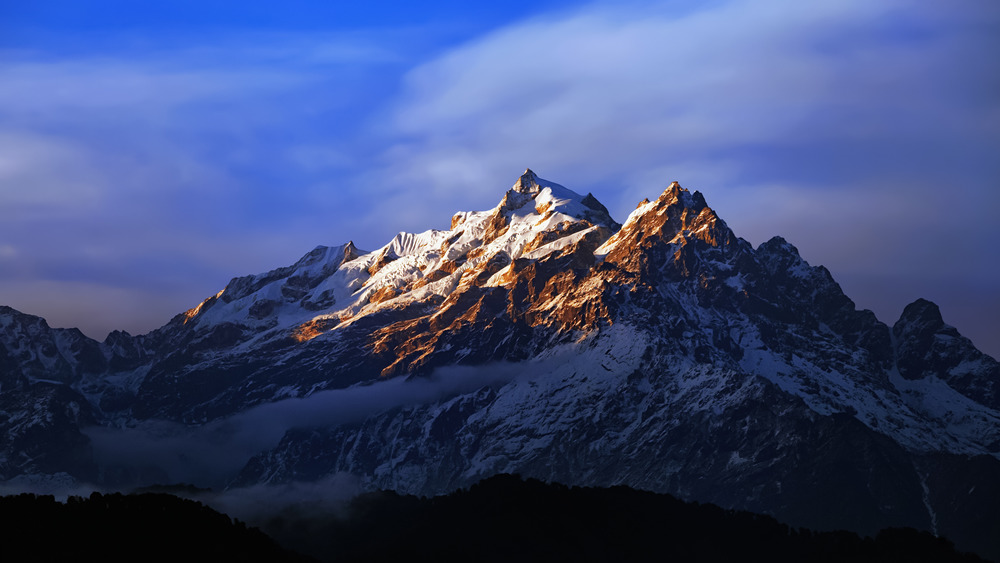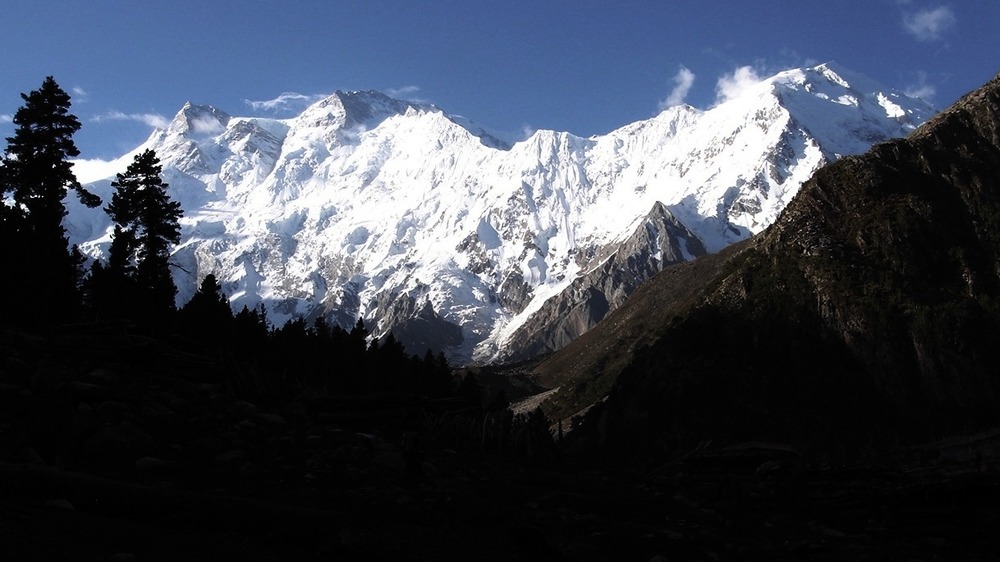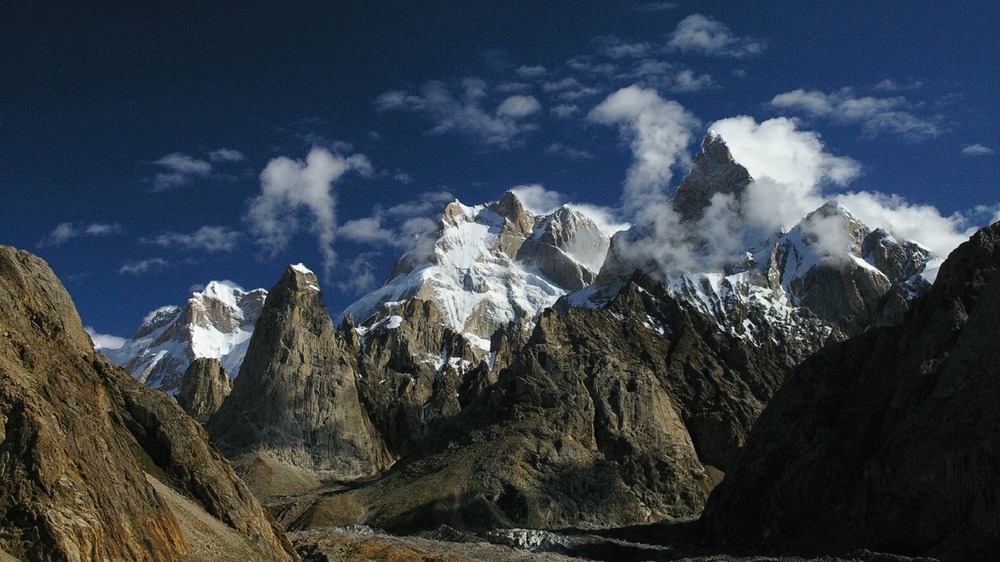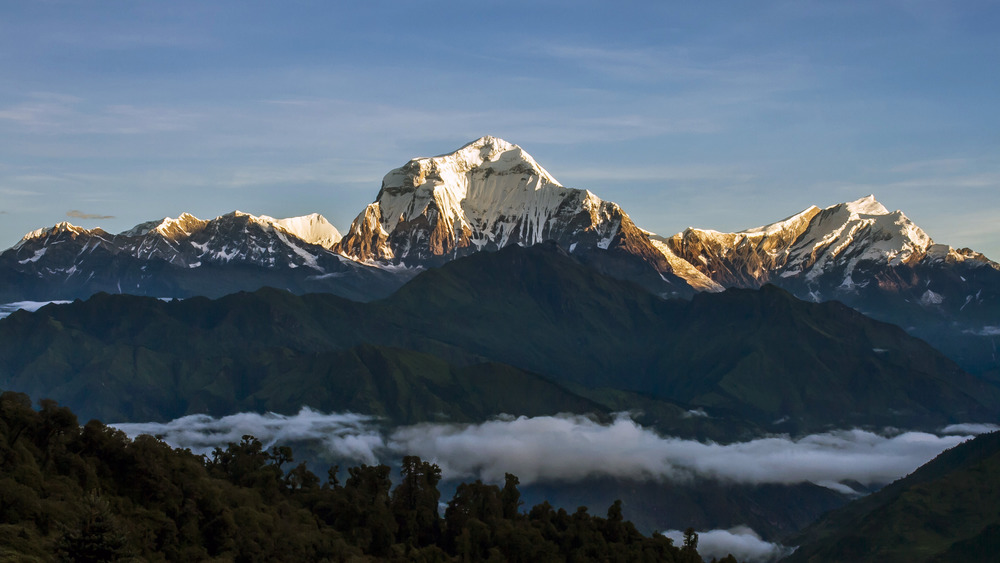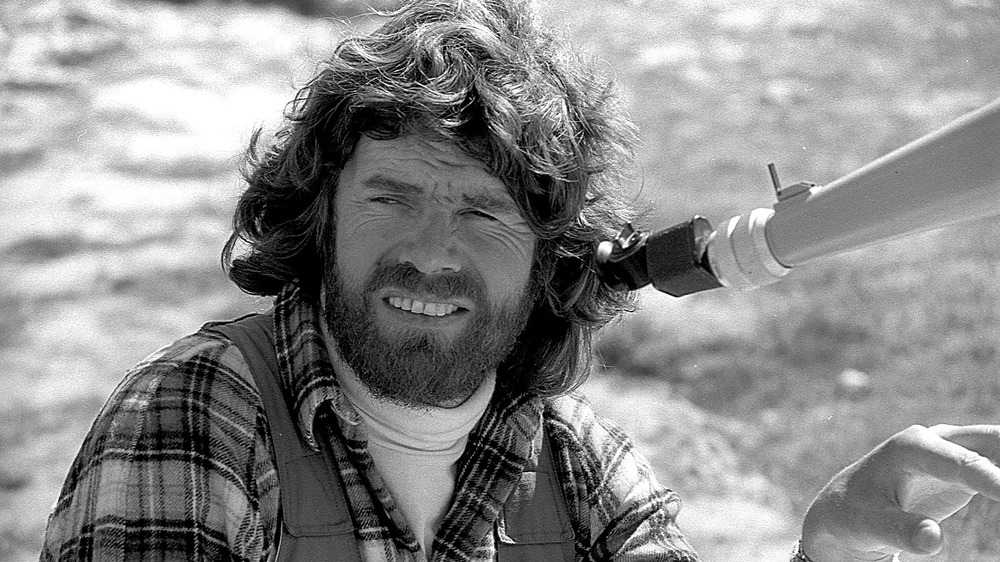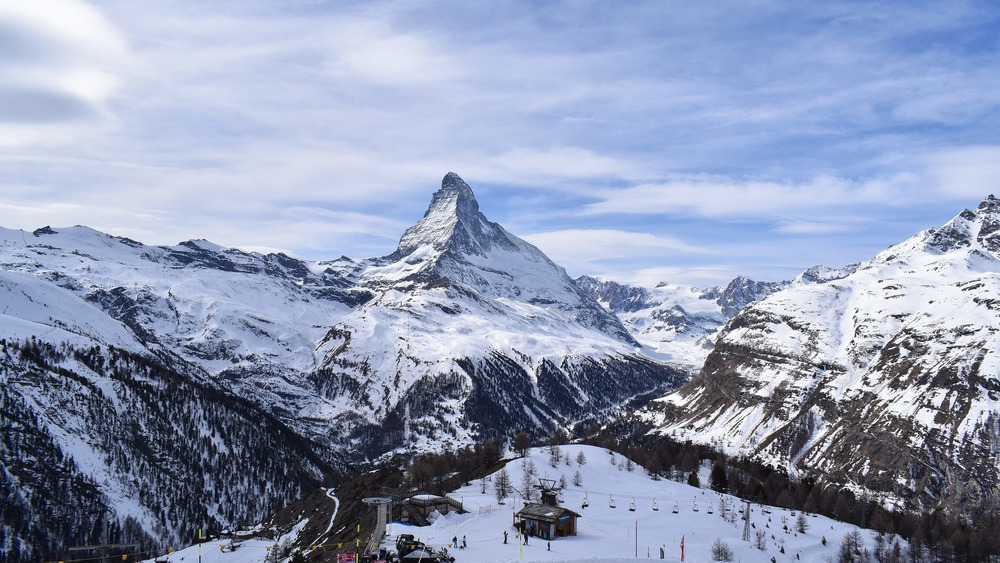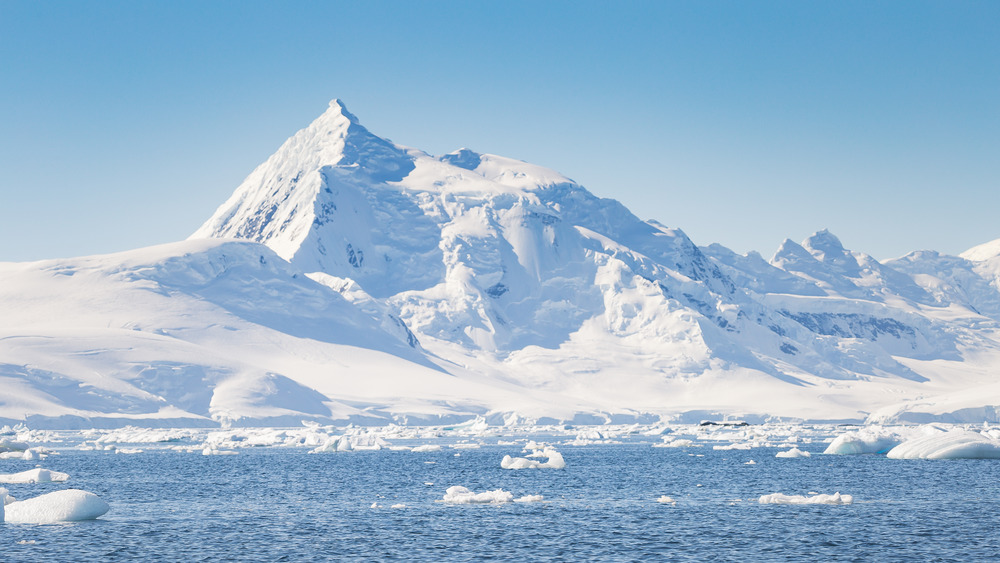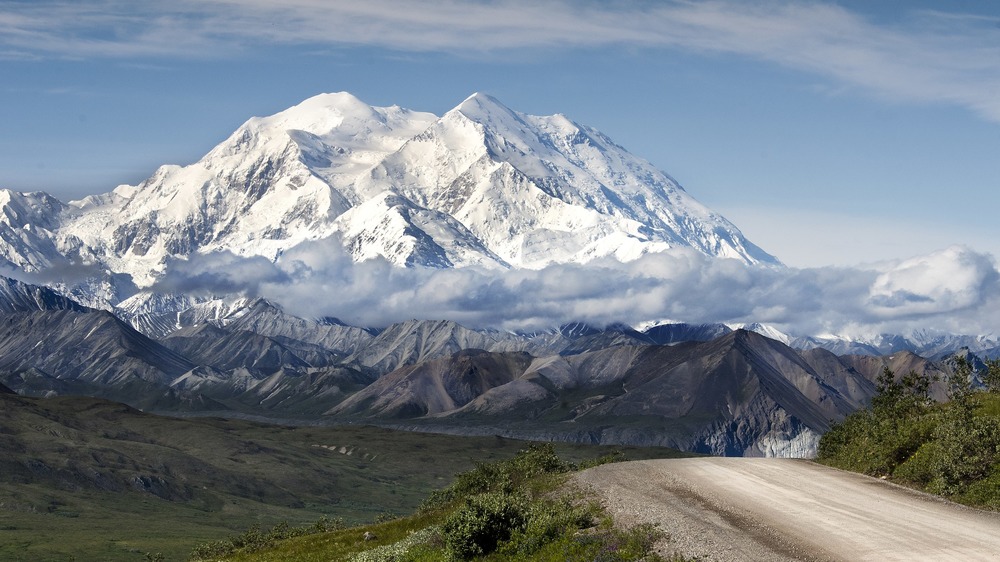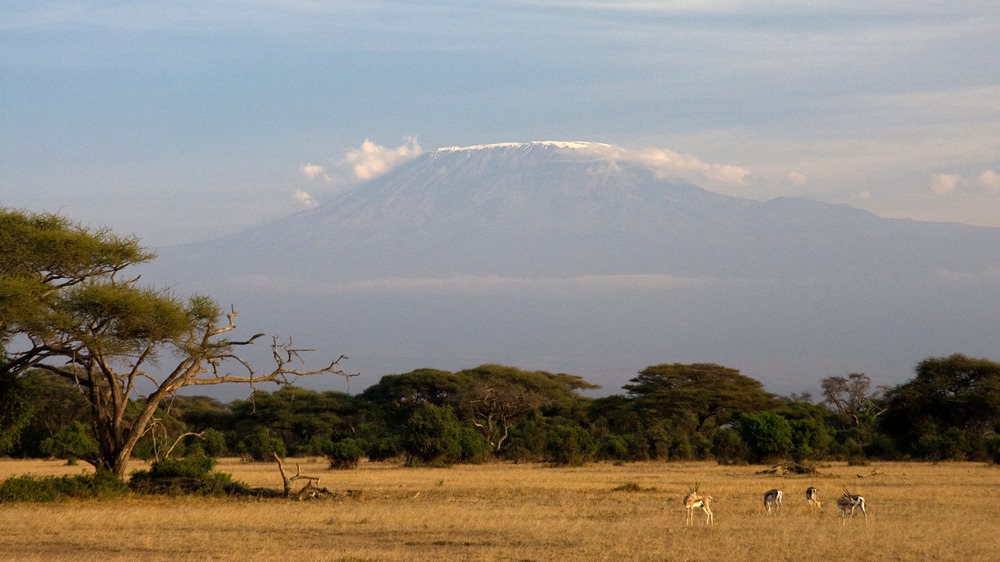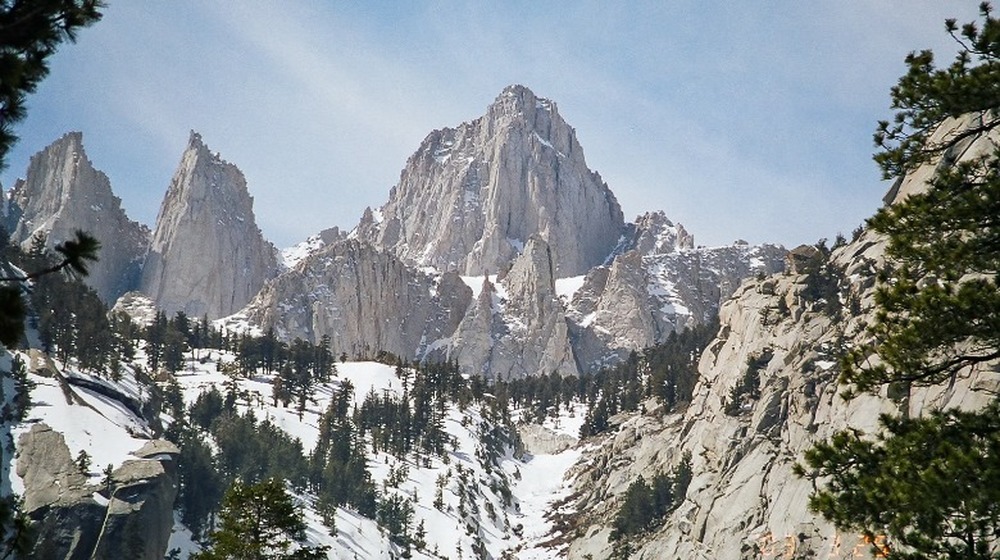The First People To Climb The World's Tallest Mountains (Besides Everest)
Mount Everest in the Himalayas is the highest point on Earth. According to National Geographic, a recent survey conducted by Nepal and China pegged the height of the mountain at 29,031.69 feet above sea level. Everest has been a source of fascination and obsession for explorers, mountaineers, and adventure tourists. However, there are other tall mountains which have proven to be more deadly and sources of greater drama. These mountains have drawn climbers who, through a lust for glory, have plunged themselves into some serious danger.
Of Earth's tallest peaks, those of the greatest height are in the Himalaya and Karakoram ranges in Central Asia. According to NASA, there are 14 mountains in that region which are over 8,000 meters tall (including Everest). These are called, in mountaineering parlance, 8,000ers. Let's take a look at a few of those peaks as well as some of the other notable mountains around the world which have offered glory and danger to those who first climbed them.
Annapurna: the first 8,000er
Annapurna is a massive Himalyan massif composed of several summits which, according to Britannica, reach a top height of 26,545 feet.
Annapurna has the distinction of being the first 8,000er to be summited by humans. According to The Independent, a French team led by Maurice Herzog and Louis Lachenal attempted to reach Annapurna's peak in 1950. The climb was a nightmare. Subjected to storms and bitter cold, Lachenal warned Herzog about the dangers of frostbite. As the two were making for the peak, he asked, "If I go back, what will you do?" Herzog replied, "I should go on by myself." Lachenal went on out of duty, knowing that if Herzog went alone, he would never return. They reached the summit on June 3.
The two climbers returned frostbitten and delirious. Herzog lost all his toes and fingers to frostbite, and Lachenal lost digits as well. Herzog went on to write the best-selling book Annapurna. The problem was that Herzog's book gave him most of the glory and relegated others in the team to the role of assistants, notably Lachenal, whose valiant role only emerged later. Regardless of the controversy, the conquest of Annapurna was an epic event in mountaineering. According to NASA, Annapurna is the deadliest 8,000er, with a 30-percent death rate.
K2: an ascent mired in controversy
The world's second-highest mountain is K2 in the Karakoram Range. According to the BBC, K2, at a mere 28,251 feet, is about 800 feet shorter than Everest. Perhaps it's because K2 plays second fiddle to Everest that it's so nasty, earning the moniker the "Savage Mountain."
According to the online sports climbing blog Rock and Ice, the first men to achieve K2's peak were an Italian expedition organized by Ardito Desio. The climbers, Achille Compagnoni and Lino Lacedelli reached the peak on July 31, 1954. However, the climb became mired in controversy, with fellow climber Walter Bonatti claiming that Lacedelli and Compagnoni had abandoned him and Hunza porter Amir Mahdi. Bonatti and Mahdi had to spend the night exposed to the chilling cold before retreating in the morning, and Mahdi lost all his toes to frostbite. Compagnoni, for his part, accused Bonatti of using his and Lacedelli's oxygen. Bonatti sued for defamation and won, but the squabbling continued for decades, with Bonatti claiming that Compagnoni and Lacedelli were jealous and plotted against him even by sabotaging the oxygen tank, which seems highly unlikely.
According to the BBC, since Lacedelli and Compagnoni's ascent, K2 has become one of the deadliest mountains in the world, killing roughly one out of every four who dare to attempt its peak.
Kanchenjunga: the Demon Mountain
Kanchenjunga in the Himalayas is the third-highest peak in the world at 28,169 feet, according to Summit magazine. The first attempt at reaching the top of this monster was made in 1905 by the famous occultist Aleister Crowley. National Geographic reports that Crowley, aside from being an accused Satanist, was an extremophile who also made the first recorded attempt to climb to the top of K2 in 1902. During his attempt on Kanchenjunga, several members of his party were killed in an avalanche. Summit reports that one of the men with him told Crowley, "The demon of Kangchenjunga was propitiated with the sacrifice." Crowley, despite his occultistic bent, decided it might be best to leave the Demon Mountain alone. He retreated.
A 1937 expedition led by the mountaineers C.R. Cooke and Sir John Hunt also ended in failure. Cooke wrote, "There is no doubt that those who first climb Kangchenjunga will achieve the greatest feat in mountaineering, for it is a mountain which combines in its defences not only the severe handicaps of wind, weather, and very high altitude, but technical climbing problems and objective dangers of an order even higher than those we encountered on Everest."
The Demon Mountain wasn't exorcized until 1955, when the British climbers Joe Brown and George Band successfully reached the summit on May 25 despite the mountain's frequent avalanches.
He went alone up the Killer Mountain
The ninth-highest mountain in the world at 26,660 feet, according to National Geographic, is Nanga Parbat in the Himalayas. Its name means "Naked Mountain," which refers to how its summit stands out against all the neighboring peaks. Among climbing circles, the mountain is also known as the "Killer Mountain." Before its peak was successfully reached, 31 climbers had died in the attempt. The feat was achieved in 1953 by the legendary Austrian climber Hermann Buhl.
According to Gripped magazine, Buhl started out on his expedition with a climbing partner, Otto Kempter. Kempter turned back, but Buhl decided to continue alone up the Killer Mountain. What's more, he climbed without taking any oxygen. He reached the summit on July 3. For the descent, he inadvertently left his ice ax on the summit and returned with only one crampon for his boot. The loss of such equipment probably didn't bother Buhl, who, as quoted in Gripped, stated, "There is probably nothing finer than to climb free and unencumbered by equipment, reveling in the gymnastic upward movement [...] relying only upon yourself, keeping a sharp eye on things, feeling the rock beneath your feet and fingertips."
Buhl's entire climb took 41 terrifying hours.
The Ogre's wrath
In Pakistan, in the Karakoram range, there is a 23,901-foot mountain that, according to Climbing magazine, is named Baintha Brakk but is better known as the "Ogre." On July 13, 1977, British climbers Doug Scott and Chris Bonington completed the ascent after over a month of exploring various ways up to its peak. The enjoyment at the top was short-lived, since on the first rappel down the mountain, Scott slid on ice and swung hard into a rock face, breaking both of his legs 9,000 feet above base camp. Bonington and Scott made camp without provisions and spent a cold night on the Ogre's spine. They continued to gingerly make their way down the mountain until they encountered two others on their team. Using snow caves for shelter, the four men sat out storms until they could continue on the journey. Scott was severely limited in movement and had to crawl and creep down the mountain. After another night in another ice cave, Bonington fell 20 feet and shattered two ribs.
Somehow, the mountaineers returned to their base camp, but then they were met with storms. They found that their team had left because of the conditions. After five days, porters arrived and brought Scott on a handmade litter to a lower camp. After a helicopter came to rescue Scott, it crash-landed. (Scott survived.) Bonington was stuck for another week before he finally escaped the Ogre. No climber would try to ascend it again for 24 years.
Diemberger reaches a castle in the clouds
Austrian Kurt Diemberger is renowned in climbing circles since, according to the International Climbing and Mountaineering Federation (UAII), he is the only living person who was the first to ascend two 8,000ers. His first was in 1957 on Broad Peak in the Karakoram. In 1960, he selected Dhaulagiri, which was thought to be the highest mountain in the world until the mid-1800s, as his next conquest. Diemberger said, "This mountain has been seen for centuries from the Indian plains, a floating white castle." Britannica shows that this massive mountain massif includes four peaks of over 26,000 feet, with Dhaulagiri I reaching 26,795 feet.
Diemberger organized the expedition with Max Eiselin of Switzerland, supported by many small donations. Diemberger recalled in an interview with the UAII, "This was an expedition which, under Swiss organisation, was the first international ascent of an 8,000-metre peak." Sixteen climbers from at least five countries joined the expedition. The Dhaulagiri expedition also featured the first time a plane was used to deliver supplies to climbers at their approximately 18,700-foot-high camp, setting a record. Unfortunately, the plane crashed after a takeoff. Even though no one was injured, it did result in isolating the groups. While the climb to the summit was not as difficult as other peaks, the expedition was plagued by storms. Finally on May 12, Diemberger's portion of the expedition reached the top of the castle in the clouds.
The first to do all 14
Every climber dreams of conquering all 14 of the 8,000er mountains. The first person to perform this remarkable feat is Italian climber Reinhold Messner. According to GQ, he began his adventures in the ultra-high mountains in 1970, when he and his brother, Günther, started on Nanga Parbat. His brother died on the expedition, with some believing that Reinhold abandoned him — Messner has vociferously denied this allegation. Messner wrote, as quoted by GQ, "It is where everything ended and everything begins."
Messner went on to perform astounding mountaineering feats. In 1978, he and a companion scaled Everest without oxygen. He did the same thing again solo two years later. He racked up each one of the 8,000ers until he finished his last one in 1986. According to National Geographic, in the 1990s, he performed difficult overland crossings of the Gobi Desert, Greenland, and Antarctica. The famed mountaineer Doug Scott, who broke his legs on the Ogre, commented to GQ that Messner is "most inspirational Himalayan climber of all time."
With all 14 of the 8,000ers conquered, what is there to do? Messner has an idea, as quoted in National Geographic: "There are millions of unclimbed mountains — I have seen in the Eastern part of Tibet, mountains 6,000–6,500 meters high [...] but nobody is going there, because they aren't 8,000-meter peaks."
The Matterhorn is conquered with tragic consequences
While the Matterhorn is not the highest mountain in the Alps, it is perhaps the most iconic. According Britannica, the peak is 14,692 feet high and is wedged between the border of Switzerland and Italy. Its raw, majestic beauty attracted the British engraver Edward Whymper who, according to Smithsonian Magazine, had come to the Alps in the 1860s. Whymper had already climbed several peaks. He tried to scale the Matterhorn but failed no less than seven times. Finally, after strategizing a new path, he and a team of seven reached the peak on July 14, 1865. Whymper must have been surprised to reach it, since no one thought to bring a flag. They used a shirt instead.
The team reveled in their victory for an hour before beginning the descent, all tied to one another. But one climber slipped, causing the group to fall down the mountain. Whymper and two others managed to secure themselves, but the rope broke. They watched in horror as four men, daisy-chained, fell. Whymper wrote in Scrambles Amongst the Alps, "For a few seconds we saw our unfortunate companions sliding downward on their backs, and spreading out their hands, endeavoring to save themselves. They passed from our sight uninjured, disappeared one by one, and fell from precipice to precipice on to the Matterhorngletscher below, a distance of nearly four thousand feet in height. From the moment the rope broke it was impossible to help them."
Climbing Antarctica's tallest mountain
Mountaineers face challenging circumstances when trying to summit an unreached peak, but when that mountain in the most remote portion of the planet you're just asking for trouble.
Mount Vinson is part of a massive subzero massif in Antarctica and is the continent's highest peak. National Geographic measures it at 16,050 feet, and it was first spotted by plane in 1935. This unique challenge interested the American Antarctic Mountaineering Expedition and the National Geographic Society, who mounted a ten-man expedition led by Nicholas Clinch in December 1966. Clinch, an unlikely hero, was reported by The New York Times to be an asthmatic, lanky attorney. However, he was a veteran climber of some the highest peaks on several continents.
The climb up Vinson itself is not considered technically difficult, but it featured 24 hours of sunlight and temperatures of around -29°F. The normal way up is a ten-day hike over the Branscomb Glacier. When Clinch reached the peak on December 20, The New York Times reported that the team pitched the flags of 12 nations.
Fires and storms won't stop these climbers
Denali, formerly called Mount McKinley, is, according to the National Park Service, 20,310 feet high, making it the highest summit in North America. In 1913, a team of four Alaskan climbers composed of Harry Karstens, Hudson Stuck, Robert Tatum, and Walter Harper approached Denali by dogsled. The process was lengthy, with the team relaying supplies which the men set in caches for the climb. In May, the team was ready after establishing the last cache. Then, to their horror, it was set ablaze, probably from an errant match. The team adjusted and then began the climb from 10,800 feet. This proved not so easy, as an earthquake from the prior year had disturbed the ice and snow.
What should have been an easy climb led to a grueling expedition that was stymied by storms, forcing the men to the relative safety of their tents. As the team pushed higher, Stuck was struck by altitude sickness, being short of breath and choking. Finally, on the morning of June 7, they departed camp for the summit in a temperature of -21°F. All four made it, although Stuck passed out on Denali's summit. After a prayer service, the men descended. Stuck recalled, "I remember no day in my life so full of toil, distress, and exhaustion, and yet so full of happiness and keen gratification."
Kilimanjaro's secret
The snow-capped Mount Kilimanjaro is a stunning contrast to the equatorial region upon which it stands. According to National Geographic, Kilimanjaro is comprised of three peaks: Kibo, Mawenzi, and Shira, with Kibo the highest at 19,340 feet. The first recorded ascent to its peak was by German geographer Hans Meyer and Austrian mountain climber Ludwig Purtscheller. Meyer, in fact, was making his second attempt at reaching the summit. According to his memoir, Across East African Glaciers, he had tried in 1887 and failed. In 1889, he tried again, this time laying in supply caches en route. He was also, according to Lonely Planet, guided by 18-year-old Tanzanian Yohani Kinyala Lauwo. The last part of the trek required them to scale a glacier. When Meyer arrived on October 6, 1889, at the highest point on Kibo, called "Uhuru," the Swahili word for "freedom," he confirmed what he suspected to be Kilimanjaro's secret — that it was a volcano.
The mountain's three peaks are volcanic cones. Mawenzi and Shira are extinct, and Kibo is dormant. Scientists believe that the last time it erupted was about 360,000 years ago. Today, thousands of people ascend Kilaminjaro since the climb does not require specialized gear. Still, many climbers suffer altitude sickness, with one Kilimanjaro climbing site, Ultimate Kilimanjaro, stating that about 1,000 are evacuated from the mountain per year, and about ten a year die, with more deaths suspected to be going unreported.
Fishing for the highest point in the continental U.S.
Mount Whitney, in the Sierra Nevada, is the highest peak in the continental United States, topping out at 14,494 feet, according the National Park Service. The prospect of being the first to ascend the mountain became a dream of geologist Clarence King. According to Britannica, after arriving in the Sierra Nevada in 1863, King first discovered Mount Whitney and was determined to return and be the first to reach its summit.
King did return in 1871 and, according to Mount Whitney by Christopher Langley and Michael Prather, made for Mount Whitney. King reached the summit, but unfortunately, it was the wrong mountain. King tried three more times to climb Mount Whitney. (On the third attempt, he again climbed the wrong peak, this time Mount Langley.) Finally, he succeeded in 1873. However, upon his return, King learned that three local fishermen, A.H. Johnson, J.J. Lucas, and C.D. Begole, had beaten him to it, with them summiting on August 18, 1873. These three dubbed the mountain "Fisherman's Peak" — the name did not stick.
